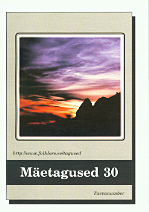Legendid ja tegelikkus Altai mäestiku Otšarovatelnaja ja Sinjaja mägi
Mt. Ocharovatelnaya and Mt. Sinyukha in Altai: Legends and Reality
Author(s): Leonid MarsadolovSubject(s): Anthropology
Published by: Eesti Kirjandusmuuseum
Summary/Abstract: The article explores the relationship between oral narrative heritage and specific material monuments on the example of two actual objects situated near the Kolyvan settlement in Western Altai. The State Hermitage Museum's archaeological fieldwork in the Sayan-Altaic region was conducted in 1993 and 1996 on Mt. Ocharovatelnaya and Mt. Sinyukha. There is a rock precipice of zoomorphic shape on Mt. Ocharovatelnaya that has been used as a sanctuary, but possibly also for astronomic observation by prehistoric people. In one observation site, the sun can be observed as setting in the mouth of an animal-shaped rock during vernal equinox - the animal as if swallows the sun. A Christian sanctuary was later erected on Mt. Sinyukha, and a wooden cross stood there even in the early 20th century. On the foot of the mountain there was an Old-Believers' nunnery. Mt. Ocharovatelnaya rises 670 m and Sinyaya Sopka, the highest peak of the Kolyvan ridge south of Mt. Ocharovatelnaya, 1,210 m above the sea level. It is a rule rather than a coincidence that the zoomorphic pagan sanctuary on Mt. Ocharovatelnaya in the north is located twice as low compared to the Christian cross on the Sinyaya mountaintop in the south. In the Christian tradition the warmer South is more revered than the cold North. In several ancient Russian geographic maps, south was situated above and north below. The position of cultic objects on mountaintops situated opposite of each other appears to symbolise the triumph of Christianity over paganism in the 18th century.
Journal: Mäetagused. Hüperajakiri
- Issue Year: 2005
- Issue No: 30
- Page Range: 131-150
- Page Count: 20
- Language: Estonian

